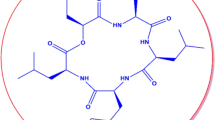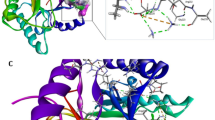Summary
The effect of Aclacinomycin B (ACM-B), an anthracycline antitumor antibiotic, on the DNA-dependent RNA synthesis using single- and double-stranded DNAs of known base content and sequence is studied. The data show that ACM-B effectively inhibits the double-stranded DNA-directed RNA synthesis with a preference of poly[d(A-T)] > poly[d(G-C)] > poly[d(I-C)]. In contrast, it has no inhibitory effect on the template function of single-stranded DNA (e.g. poly dA, poly dT, and poly dC). These results suggest that the mechanism of ACM-13 inhibition, like other anthracycline antibiotics, is by intercalation. In addition to the base specificity, there are also dramatic differences in inhibition depending on the base sequence in the DNA template. Thus, ACM-13 preferentially inhibits the alternating double-stranded copolymers over the double-stranded homopolymers; e.g. poly [d(A-T)] is inhibited to a greater extent than poly dA · poly dT and poly [d(G-C)] is inhibited more than poly dG · poly dC. Since the inhibition by ACM-13 can be totally abolished when assayed in excess amount of DNA, this result suggests that ACM-B inhibition of RNA synthesis is solely on the DNA template (which is in support of the intercalation model), and has ruled out the possibility that ACM-B may also exert an inhibitory effect on the activity of RNA polymerase per se.
Similar content being viewed by others
References
Oki T, Matsuzawa Y, Yoshimoto A, Numata K, Kitamura I, Hori S, Takamatsu A, Umezawa H, Ishizuka M, Naganawa H, Suda H, Hamada M, Takeuchi T: New antitumor antibiotics, aclacinomycins A and B. J Antibiotic 28: 830–834,1975
Sheng WM, Yan HF, Pang XX: The effect of aclacinomycin B on the growth of L1210 mouse leukemia cell in vitro and Lewis lung cancer in vivo. Chinese J Antibiot 8: 290–295, 1983
Li LH, Wang YS, Li GR: Effects of aclacinomycin B on nucleolar ultrastructure and function of RNA synthesis of human gastric cancer cells. Acta Pharmacol Sinica 8: 266–271,1987
Oki T: New anthracycline antibiotics. Jap J Antibiotics 30 (Suppl): 70–84, 1977
Oki T, Kitamura I, Matsuzawa Y, Shibamota N, Ogasawaru T, Yoshimato A, Inui T: Antitumor anthracycline antibiotics, acalacinomycin A and analogues. II. Structure determination. J Antibiotics 32: 801–819, 1979
DuVernay VH Jr: Eubanks D, Perales R, Prestayko AW, Crooke ST: The antitumor effects of anthracyclines, II. The stereo-specificity of the carbomethoxy group at position 10 of the class II anthracycline molecule. Mol Pharmacol 21: 196–203,1982
DuVernay VH Jr, Pachter JA, Crooke ST: DNA binding studies on several new anthracycline antitumor antibiotics. II. The importance of the carbomethoxy-group at position-10 of the class II anthracycline molecule. Mol Pharmacol 16:623–632, 1979
Crooke ST, DuVernay VH, Galvan L, Prestayko AW: Structure-activity relationships of anthracyclines relative to effects on macromolecular syntheses. Mol Pharmacol 14: 290–298,1978
DuVernay VH Jr, Pachter JA, Crooke ST: Deoxyribonucleic acid binding studied on several new anthracycline antitumor antibiotics. Sequence preference and structure-activity relationships of marcellomycin and its analogues as compared to adriamycin. Biochemistry 18: 4025–4030,1979
Yamaki H, Suzuki H, Nishimuro T, Tanaka N: Mechanism of action of aclacinomycin A. I. The effect on macromolecular syntheses. J Antibiotics 31: 1149–1154, 1978
Komiyama T, Oki T, Inui T: Interaction of new anthracycline antibiotics with DNA effects on nucleic acid synthesis and binding to DNA. Biochim Biophys Acta 740: 80–87,1983
Yu FL: An improved method for the quantitative isolation of rat liver nuclear RNA polymerase. Biochim Biophys Acta 395: 329–336, 1975
Yu FL: Mechanism of aflatoxin B, inhibition of rat hepatic nuclear RNA synthesis. J Biol Chem 252: 3245–3251, 1977
Yu FL, Geronimo IH, Bender W, Dowe RJ: Errors from using 3H-labelled ribonucleoside triphosphates to monitor nuclear RNA synthesis. J Biochem Biophys Methods 13: 333–342,1987
Yu FL: Ribohomopolymer formation as a source of error in the radio-active precursor incorporation studies of nuclear DNA-dependent RNA synthesis. Life Sciences 18: 1171–1176,1976
Muller W, Crothers DM: Studies of the binding of actinomycin and related compounds to DNA. J Mol Biol 35: 251–290,1968
Wells RD, Larson JE: Studies on the binding of actinomycin D to DNA and DNA model polymers. J Mol Biol 49: 319–342,1970
Sobell HM, Jain SC, Sakore TD: Stereochemistry of actinomycin-DNA binding. Nature 231: 200–205, 1971
Lerman LS: Structural consideration in the interaction of DNA and acridines. J Mol Biol 3: 18–30, 1961
LePecq JB, Paoletti C: A fluorescent complex between ethidium bromide and nucleic acids. J Mol Biol 27: 87–106, 1967
Chuang RY, Chuang LF: Inhibition of chicken myeloblastosis RNA polymerase II activity by adriamycin. Biochemistry 18: 2069–2073, 1979
Chuang LF, Kawahata RT, Chuang RY. Inhibition of chicken myeloblastosis RNA polymerase II activity in vitro by N-trifluorocetyladriamycin-14-valerate. FEBS Lett 117: 247–251,1980
Lameh J, Chuang LF, Chuang RY, Israel M: Inhibition of initiation of transcription of human leukemic cells in vitro by N-trifluoroacetyladriamycin-14–0-hemiadipate (AD143). Proceedings of the 79th annual meeting of American Association for Cancer Research 29: 273 (Abs. 1085), 1988
Author information
Authors and Affiliations
Rights and permissions
About this article
Cite this article
Li, Lh., Yu, FL. Template specificities of Aclacinomycin B on the inhibition of DNA-dependent RNA synthesis in vitro . Mol Cell Biochem 90, 91–97 (1989). https://doi.org/10.1007/BF00225224
Received:
Accepted:
Issue Date:
DOI: https://doi.org/10.1007/BF00225224




